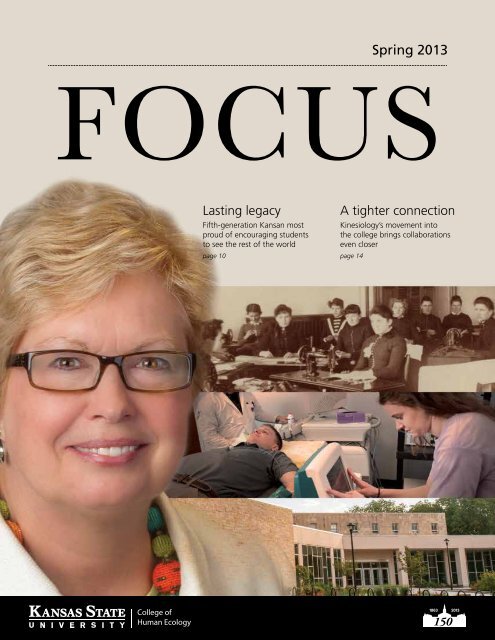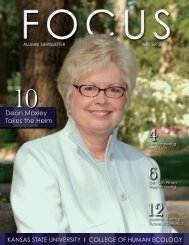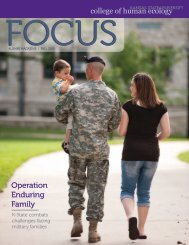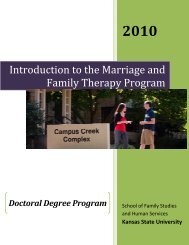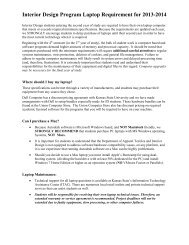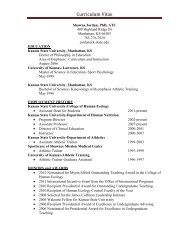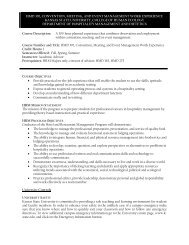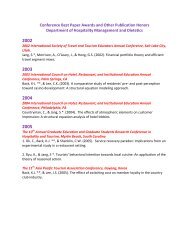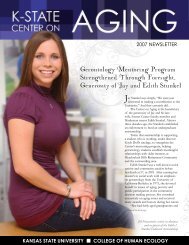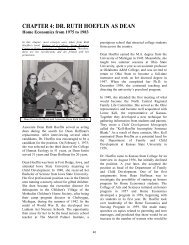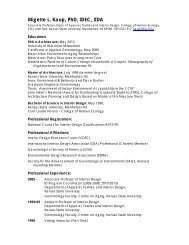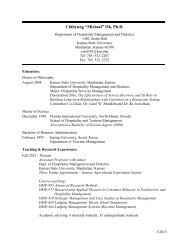Spring 2013 - College of Human Ecology - Kansas State University
Spring 2013 - College of Human Ecology - Kansas State University
Spring 2013 - College of Human Ecology - Kansas State University
You also want an ePaper? Increase the reach of your titles
YUMPU automatically turns print PDFs into web optimized ePapers that Google loves.
<strong>Spring</strong> <strong>2013</strong><br />
FOCUS<br />
Lasting legacy<br />
Fifth-generation Kansan most<br />
proud <strong>of</strong> encouraging students<br />
to see the rest <strong>of</strong> the world<br />
page 10<br />
A tighter connection<br />
Kinesiology’s movement into<br />
the college brings collaborations<br />
even closer<br />
page 14<br />
<strong>College</strong> <strong>of</strong><br />
<strong>Human</strong> <strong>Ecology</strong>
Message from the dean<br />
It has been my privilege to serve as dean <strong>of</strong> the <strong>Kansas</strong> <strong>State</strong> <strong>University</strong><br />
<strong>College</strong> <strong>of</strong> <strong>Human</strong> <strong>Ecology</strong> at an extraordinary time.<br />
I came to this position in January 2006 with high expectations for the<br />
work <strong>of</strong> the college. <strong>College</strong> faculty, students and staff have consistently<br />
exceeded my expectations. Their accomplishments have been truly<br />
remarkable. This success would not have been possible without the<br />
extraordinary support provided by alumni and friends <strong>of</strong> the college.<br />
Last fall I announced that I will retire as dean in June. As I prepare to<br />
move into a new era in my life, I feel a sense <strong>of</strong> pr<strong>of</strong>ound gratitude and<br />
admiration for all <strong>of</strong> you whose collective endeavors and contributions<br />
have made, and will continue to make, this a great college.<br />
The intellectual vibrancy <strong>of</strong> the college is a tangible thing. You feel it in our classes and<br />
laboratories, in conversations with faculty and students who are energized and enriched by<br />
their work.<br />
Our graduates are exceptionally well prepared for pr<strong>of</strong>essional roles. As students they are<br />
immersed into the culture and practice <strong>of</strong> the pr<strong>of</strong>ession; they have been abroad learning<br />
from travel, study and work in diverse settings; they share a concern for human significance<br />
as one <strong>of</strong> their core values.<br />
Our facilities are a model <strong>of</strong> sustainable and functional design. Classrooms are designed to<br />
maximize learning. New space for research is under development.<br />
This year the college has continued to achieve remarkable outcomes, including:<br />
• personal financial planning students and interior design students winning first place in<br />
national competitions;<br />
• the college using classrooms and <strong>of</strong>fices in the Justin Hall expansion;<br />
• welcoming the Department <strong>of</strong> Kinesiology into the college;<br />
• the college creating the Physical Activity and Nutrition Clinical Research Consortium,<br />
located in Lafene Health Center; and<br />
• Gayle Doll, Ann Smit and Sandi Stith being named national fellows in their respective<br />
pr<strong>of</strong>essional fields.<br />
Celebrating the 150th anniversary <strong>of</strong> <strong>Kansas</strong> <strong>State</strong> <strong>University</strong> this year is a special pleasure.<br />
This state and this university have come a long way in the past 150 years. The <strong>College</strong> <strong>of</strong><br />
<strong>Human</strong> <strong>Ecology</strong> marks its beginning 140 years ago when the newly appointed President<br />
John Anderson proposed the first three courses <strong>of</strong> study — the farmers course (now the<br />
<strong>College</strong> <strong>of</strong> Agriculture), the mechanics course (now the <strong>College</strong> <strong>of</strong> Engineering), and the<br />
women’s course (now the <strong>College</strong> <strong>of</strong> <strong>Human</strong> <strong>Ecology</strong>).<br />
Because <strong>of</strong> the prominence <strong>of</strong> the early faculty and administrators in this college, <strong>Kansas</strong><br />
<strong>State</strong> <strong>University</strong> has more buildings named for women than any other public institution<br />
in the United <strong>State</strong>s. When the first three K-<strong>State</strong> buildings were named in 1902 by the<br />
university’s Board <strong>of</strong> Regents, the general classroom building was named Anderson Hall for<br />
the university’s second president; the library was named Fairchild Hall for the <strong>University</strong>’s<br />
third president; and the Domestic Science Hall was named for Nellie Kedzie, K-<strong>State</strong>’s first<br />
female pr<strong>of</strong>essor and head <strong>of</strong> the domestic science program.<br />
The <strong>College</strong> <strong>of</strong> <strong>Human</strong> <strong>Ecology</strong> has a long and distinguished history. Its future promises to be<br />
even more exciting.<br />
<strong>Human</strong> <strong>Ecology</strong> will continue to be a great place to work and learn. It will remain a<br />
powerhouse for discoveries that advance human health and well-being. It will continue to<br />
prepare graduates for pr<strong>of</strong>essional leadership.<br />
Thank you for being a part <strong>of</strong> our progress.<br />
Table <strong>of</strong> contents<br />
Success built on a limestone foundation..... 4<br />
Unparalleled perspective............................ 6<br />
Are you smarter than an 1877 student..... 7<br />
Meet the women who shaped<br />
the college................................................. 8<br />
Lasting legacy.......................................... 10<br />
A tighter connection................................ 14<br />
Building on strength................................ 15<br />
A quick look at what’s going on<br />
in the college........................................... 16<br />
<strong>Spring</strong> events........................................... 21<br />
Fighting for families................................. 22<br />
Dean Virginia Moxley
1960<br />
c. 1960<br />
1873<br />
1959<br />
2012<br />
1912<br />
150 years in the making<br />
Happy birthday, K-<strong>State</strong>.<br />
As <strong>Kansas</strong> <strong>State</strong> <strong>University</strong> celebrates its sesquicentennial, the<br />
<strong>College</strong> <strong>of</strong> <strong>Human</strong> <strong>Ecology</strong> turns 140.<br />
In 1863, just two years after <strong>Kansas</strong> entered the Union as a free<br />
state, a little school called Bluemont Central <strong>College</strong> became <strong>Kansas</strong><br />
<strong>State</strong> Agricultural <strong>College</strong>. It was the first land-grant school in the<br />
United <strong>State</strong>s to open its doors.<br />
In 1873, college president John A. Anderson organized the college<br />
into three units — one for the students who wished to be farmers,<br />
one for those who wanted to be “mechanics or industrial citizens”<br />
and one for the “young ladies.”<br />
Modern students may frown on the classifications, but Anderson<br />
was ahead <strong>of</strong> his time on the American frontier. He believed a<br />
woman should be educated, despite the literature <strong>of</strong> the day that<br />
declared that education physically harmed females. A woman should<br />
be “an industrialist instead <strong>of</strong> a butterfly,” he said.<br />
That program sprouted and grew into the <strong>College</strong> <strong>of</strong> <strong>Human</strong><br />
<strong>Ecology</strong>, which today has more than 3,000 students, a new $5<br />
million wing on Justin Hall, more than $21 million in extramural<br />
funding and more than $19 million in endowments.<br />
With this issue <strong>of</strong> Focus, we salute that 14-decade journey and the<br />
leaders — several <strong>of</strong> them former students <strong>of</strong> the college — who<br />
forged the way.<br />
Take a look at the university’s 150th celebration at k-state.edu/150.<br />
And look at our 150th website — he.k-state.edu/150 — and read<br />
about our sesquicentennial plans and highlights <strong>of</strong> our history.<br />
Mark your calendars now and plan to attend <strong>College</strong> <strong>of</strong> <strong>Human</strong><br />
<strong>Ecology</strong> festivities during homecoming weekend Oct. 24-26.<br />
And join us to honor the past, celebrate the present and welcome<br />
the future.<br />
3
Past<br />
Success built on a limestone foundation<br />
Six limestone buildings tell the story <strong>of</strong> <strong>Human</strong> <strong>Ecology</strong>’s 140-year<br />
heritage. Within the rock walls <strong>of</strong> these six buildings beats the heart<br />
<strong>of</strong> the college — the leaders, the faculty, the staff, the students.<br />
Bluemont Building<br />
Anderson Hall<br />
In 1859, on a hill west <strong>of</strong> the newly formed town <strong>of</strong> Manhattan,<br />
Isaac T. Goodnow established Bluemont Central <strong>College</strong>, a primary<br />
and preparatory school, to promote education and science in the<br />
<strong>Kansas</strong> Territory. Less than a month after <strong>Kansas</strong> became a state in<br />
1861, school trustees sought state university status. They promised<br />
to donate land and their 44-by-60-foot limestone building. The<br />
Morrill Act strengthened their case and in 1863 <strong>Kansas</strong> <strong>State</strong><br />
Agricultural <strong>College</strong> became the first land-grant institution to open<br />
its doors to students. In 1873 when President John A. Anderson<br />
established three divisions <strong>of</strong> study — domestic science, agriculture<br />
and engineering — Hattie Cheseldine taught 12 women sewing,<br />
dressmaking and millinery on the stage <strong>of</strong> the Bluemont Building.<br />
The students learned to disassemble and reassemble the college’s<br />
one sewing machine. The teacher earned $35 a month. The building<br />
was razed in 1883.<br />
Farm Machinery Hall<br />
In 1875 domestic science classes moved, with the young college,<br />
to the present campus where the main building was the Farm<br />
Machinery Hall. On the second floor Mary E. Cripps, a successful<br />
millenary businesswoman from New York, taught sewing and<br />
household<br />
economics.<br />
Chemistry pr<strong>of</strong>essor<br />
William K. Kedzie<br />
instructed the<br />
young women<br />
in household<br />
chemistry. This class<br />
later transferred<br />
to human ecology<br />
and became human<br />
nutrition. Domestic<br />
science was made a department in 1876 — the Department <strong>of</strong><br />
Household Economy. The building was razed in 1963.<br />
At a cost <strong>of</strong> $20,000 — $6,500 for the stonework alone —<br />
Anderson Hall added a south wing in 1885. Sewing classes moved<br />
to the new first-floor sewing room, which was top <strong>of</strong> the line with<br />
six machines, dress forms and patterns. A model kitchen, dining<br />
room furniture and a dairy were in the basement. Faculty numbered<br />
two: Nellie Sawyer Kedzie and Elida Winchip.<br />
Kedzie Hall<br />
The building, completed<br />
in 1898, is believed to be<br />
the first structure built<br />
for home economics in<br />
the world. First called the<br />
Domestic Science Building,<br />
it was renamed for Nellie<br />
4
FOCUS<br />
“What is done for the boy in agriculture and engineering<br />
must be done for the girl in domestic science and art.”<br />
Past<br />
— Pr<strong>of</strong>essor Minnie A. Stoner at the dedication <strong>of</strong> Domestic Science Hall (later renamed for Nellie Kedzie) in 1898<br />
Kedzie, who personally lobbied the <strong>Kansas</strong> Legislature for the<br />
$16,000 needed for building and equipment. Kedzie headed home<br />
economics from 1882 to 1897 and was the first female pr<strong>of</strong>essor at<br />
K-<strong>State</strong>. The building was one <strong>of</strong> the first three named for campus<br />
leaders. They were Anderson Hall, Fairchild Hall and Kedzie Hall.<br />
Calvin Hall<br />
The next home, built<br />
in 1908, was the<br />
new $70,000 Calvin<br />
Hall, named after<br />
pr<strong>of</strong>essor Henrietta<br />
Willard Calvin. How<br />
modern we were<br />
— laboratories,<br />
lecture halls, sewing<br />
rooms, exhibit rooms, a large dining room with eight individual<br />
kitchens. We operated a cafeteria to feed students and to serve as a<br />
laboratory for institutional management students. Domestic Science<br />
now included home management, food instruction, home nursing,<br />
home sanitation, house building and furnishing. A nursery school<br />
opened in 1926 in Calvin Hall. Mary P. Van Zile, who was in charge<br />
<strong>of</strong> the curriculum, taught a class in table manners to senior men for<br />
25 cents, meal included. She discouraged them from drinking from<br />
saucers. That year football came to campus and a movie theater<br />
came to Manhattan. <strong>College</strong> President Ernest R. Nichols boasted <strong>of</strong><br />
an enrollment <strong>of</strong> 2,166 students at the university.<br />
Justin Hall<br />
$2,125,000. It was top <strong>of</strong> the line and included air conditioning, 28<br />
teaching labs, 23 research labs, eight classrooms and a lecture hall<br />
that seated 220. In 1985 the college became <strong>Human</strong> <strong>Ecology</strong>.<br />
Justin Hall expansion<br />
Justin Hall was built to accommodate a burgeoning student<br />
enrollment <strong>of</strong> 1,000. Student population had nudged the 2,000 mark<br />
and was still skyrocketing. The business <strong>of</strong> educating, researching<br />
and meeting the needs <strong>of</strong> students, staff and faculty changed.<br />
<strong>Human</strong> <strong>Ecology</strong> needed more space for students to work together,<br />
for seminars and large high-tech classrooms. In September 2012,<br />
Dean Virginia Moxley led dedication ceremonies for a 13,180-squarefoot<br />
expansion to 50-year-old Justin Hall. The $5-million addition was<br />
financed entirely by alumn and friends <strong>of</strong> the college.<br />
In 1959, the year the Carey brothers celebrated the first year <strong>of</strong><br />
the new business in Wichita called Pizza Hut, the <strong>College</strong> <strong>of</strong> Home<br />
Economics moved into Justin Hall. It was built under the judicious eye<br />
<strong>of</strong> Dean Doretta H<strong>of</strong>fman and named for Margaret Justin, who was<br />
dean for 31 years. The building boasted 102,004 square feet and cost<br />
1903<br />
5
Past<br />
Unparalleled perspective<br />
<strong>College</strong>’s oldest graduate lived the college’s history<br />
Edith Leora Lale is the <strong>College</strong> <strong>of</strong> <strong>Human</strong> <strong>Ecology</strong>’s oldest living graduate.<br />
The 108-year-old graduated from <strong>Kansas</strong> <strong>State</strong> Agricultural <strong>College</strong> in 1928.<br />
She took home economics classes in Calvin Hall and studied from “Practical<br />
Cookery,” first published by members <strong>of</strong> foods and nutrition in 1912, revised<br />
and used until the turn <strong>of</strong> the millennium.<br />
The Lale family farmed in Missouri, and both Edith<br />
and her younger sister Mildred earned home<br />
economics degrees from K-<strong>State</strong>. While Edith<br />
was on campus, Margaret Justin was dean <strong>of</strong> the<br />
Division <strong>of</strong> Home Economics; Francis David Farrell<br />
led the university; the library was built. Tuition<br />
was free, although students paid $33 in fees each<br />
semester; the students numbered around 4,000.<br />
Miss Lale took on the role <strong>of</strong> family caretaker after<br />
graduating a year before the Great Depression.<br />
She never married, had a career or got a driver’s license. She did live with sister<br />
Mildred, manage the household, cook, sew and make lye soap long after it was<br />
a necessity. “She once told me she never had to punch a time clock or answer<br />
to anybody else,” said Ann Newton, whose mother was Miss Lale’s first cousin.<br />
The Lale sisters moved later to Louisville, Ky., to be near other family members<br />
so they could “look out for each other,” Mrs. Newton continued. “Edith was<br />
always in caregiver mode. She took care <strong>of</strong> her mother and grandmother, three<br />
generations living in a big stone house in Louisville.”<br />
She did volunteer work, Mrs. Newton remembers, but her obsession was family<br />
history. Miss Lale didn’t track family genealogy, but she has written stories about<br />
family events, collected photographs and made books on her immediate family<br />
members. “I have some <strong>of</strong> those books, and so do relatives in Missouri,” Mrs.<br />
Newton said. “They are really interesting to read. She used a typewriter until<br />
about five years ago.”<br />
Edith and Mildred Lale invested in Treyton Oak Towers when it was built nearly<br />
three decades ago in the heart <strong>of</strong> Old Louisville. They moved into a large<br />
apartment where, after her sister died, Miss Lale lived until last year when she<br />
required assisted living.<br />
“She’s something else,” Mrs. Newton said in a telephone conversation.<br />
“Her mind was sharp until very recently. She gets around using a<br />
wheelchair. She still loves to eat and is very talkative.<br />
“She is an institution at Treyton Oak.”<br />
The <strong>College</strong> <strong>of</strong> <strong>Human</strong> <strong>Ecology</strong> got its <strong>of</strong>ficial start wh<br />
organized practical courses for women students and<br />
economics to the world. In 1873 <strong>Kansas</strong> <strong>State</strong> Agricultural Co<br />
this new form <strong>of</strong> education for women. Since then it has exp<br />
1873 Wom<br />
1880 Department <strong>of</strong> S<br />
1897 D<br />
19<br />
1<br />
19<br />
1<br />
6
Past<br />
Are you smarter than an 1877 student<br />
The Catalogue <strong>of</strong> the <strong>Kansas</strong> <strong>State</strong> Agricultural <strong>College</strong> <strong>of</strong> 1877-78 instructs<br />
students on expenses (“Tuition is free, and no charges are made for incidental<br />
or ‘contingent’ expenses”), on faculty names and titles (There were 12, counting<br />
President George T. Fairchild, pr<strong>of</strong>essor <strong>of</strong> political economy), and on courses <strong>of</strong><br />
study (Offerings for first-year, second-year, third-year and fourth-year students<br />
were divided in to three terms — fall, winter and spring).<br />
On page 32 the booklet addresses admission: “Candidates for admission<br />
… must be at least fourteen years <strong>of</strong> age, and able to pass a satisfactory<br />
examination in reading, spelling, writing, arithmetic to percentage, geography<br />
and elements <strong>of</strong> English grammar.”<br />
Then it gives some sample arithmetic questions. No calculators were allowed.<br />
The catalog did not give the answers so we asked Robert B. Burckel, pr<strong>of</strong>essor <strong>of</strong><br />
mathematics, for some help. We thank Dr. Burckel for his answers and annotations.<br />
en President John A. Anderson<br />
, in doing so, introduced home<br />
llege was the pioneer school in<br />
erienced several name changes:<br />
en’s course/Domestic economy<br />
ewing and Household Economy<br />
epartment <strong>of</strong> Domestic Science<br />
12 Division <strong>of</strong> Home Economics<br />
942 School <strong>of</strong> Home Economics<br />
63 <strong>College</strong> <strong>of</strong> Home Economics<br />
985 <strong>College</strong> <strong>of</strong> <strong>Human</strong> <strong>Ecology</strong><br />
...<br />
How many barrels, each holding 2 bushels and 3 pecks, will be<br />
needed to contain 880 bushels <strong>of</strong> apples<br />
... Probably it was not an issue with farm kids in 1877, but no student<br />
(or adult) today could relate pecks to bushels. A dictionary informs us<br />
that a bushel is 4 pecks, so the problem is telling us that a barrel holds<br />
2 + ¾ = 11 ⁄4 bushels. Thus one wants to know how many times this<br />
number is present in 880; that is, one divides 880 by 11 ⁄4 (equivalently,<br />
one multiplies 880 by 4 ⁄11). Of course, a fractional answer will have to<br />
be rounded upward, as there are no fractional barrels.<br />
...<br />
...<br />
Add 3 ⁄5, 4 ⁄7, 13 ⁄21, and 7 ⁄15.<br />
For a bunch <strong>of</strong> dimes and quarters one only needs a common unit<br />
<strong>of</strong> currency, nickels. Here a common unit is 1 ⁄105 (105 = 3 times 5<br />
times 7): 3 ⁄5 = 63 ⁄105, 4 ⁄7 = 60 ⁄105, 13 ⁄21 = 65 ⁄105, 7 ⁄15 = 49 ⁄105. Altogether<br />
there are 63 + 60 + 65 + 49 = 237 <strong>of</strong> these 1 ⁄105 ‘s. That is, 237 ⁄105 (=<br />
79⁄35 in ‘lowest terms’, if you prefer).<br />
...<br />
How many cords in a pile <strong>of</strong> four-foot wood, five feet six inches high<br />
and twenty-three feet long<br />
... Today only tradesmen know the definition <strong>of</strong> “cord,” so the present<br />
wording is hardly suitable for 21st-century students. A dictionary<br />
clarifies that a cord is 128 cubic feet. The given volume <strong>of</strong> wood is<br />
(4 feet) times (5.5 feet) times (23 feet) = 506 cubic feet. Each 128<br />
cubic feet <strong>of</strong> this is 1 cord, so you’re simply being asked how many<br />
128’s there are in 506.<br />
...<br />
If by selling cloth at $0.75 a yard I gain 18 ¾ percent on the cost,<br />
how much must I advance up on this price to gain 31¼ percent on<br />
the cost (From the 1882-82 catalogue)<br />
... If the problem is saying that a price <strong>of</strong> 75 earns 18 percent pr<strong>of</strong>it and<br />
wants to know what price will earn 31 percent pr<strong>of</strong>it, we can proceed<br />
as follows: The “given” is that 75 = cost + pr<strong>of</strong>it = cost + 18 percent<br />
<strong>of</strong> cost = cost + .18 cost = 1.18 cost. Therefore, cost = 75 ⁄1.18. To<br />
earn 31 percent pr<strong>of</strong>it on this cost means we must charge cost + 31<br />
percent cost = cost + .31 cost = 1.31 cost = 1.31 times 75 ⁄1.18. You can<br />
do this arithmetic. (Of course, the unit <strong>of</strong> cost is cents-per-yard.)<br />
7
Past<br />
Meet the women wh<br />
Hattie Cheseldine (1873-1875)<br />
taught dressmaking and sewing<br />
for the brand new “women’s<br />
courses” at <strong>Kansas</strong> <strong>State</strong><br />
Agricultural <strong>College</strong>.<br />
The classes are<br />
believed to be<br />
the first to<br />
give academic<br />
credit for<br />
women at<br />
a land-grant<br />
college.<br />
Nellie Sawyer Kedzie (1882-1897)<br />
was the first woman to hold pr<strong>of</strong>essor<br />
rank and the first female<br />
department head at<br />
<strong>Kansas</strong> <strong>State</strong> Agricultural<br />
<strong>College</strong>. She was<br />
an influential national<br />
leader in what became<br />
home economics,<br />
building programs at<br />
K-<strong>State</strong>, in Illinois<br />
and Wisconsin.<br />
The world’s first<br />
domestic science<br />
building was built<br />
on campus in<br />
1897 and renamed<br />
for her<br />
in 1902.<br />
Dean Mary Pierce Van Zile<br />
(1908-1918) was also<br />
dean <strong>of</strong> women, a job she<br />
continued until 1939. The<br />
first residence hall, open<br />
to students in 1926, was<br />
named in her honor.<br />
Dean Helen Bishop Thompson<br />
(1918-1923) developed a<br />
plan for a master’s degree in<br />
home economics, initiated a<br />
five-year curriculum in home<br />
economics and nursing,<br />
and created a child welfare<br />
program as dean. Thompson<br />
Hall, a cafeteria building, was named in<br />
her honor in 1925.<br />
1863 1873 1883 1893 1903 1913 1923 1933<br />
Mary Cripps (1875-1882)<br />
was superintendent <strong>of</strong><br />
sewing in 1875 and<br />
taught household<br />
economics and<br />
hygiene. The classes<br />
moved from the<br />
Bluemont Central<br />
<strong>College</strong> Building to<br />
the only building<br />
on the new<br />
campus<br />
— Farm<br />
Machinery<br />
Hall.<br />
Much <strong>of</strong> this information was adapted from<br />
“Legacy <strong>of</strong> Leadership” by Carol Kellett. To learn<br />
about the book, see he.k-state.edu/150/library.<br />
Henrietta Willard Calvin<br />
(1903-1908) joined the<br />
faculty after numerous<br />
leadership changes.<br />
A widow, she moved<br />
to Manhattan with<br />
her five children.<br />
She organized<br />
the first summer<br />
school at K-<strong>State</strong>.<br />
It was for teachers<br />
<strong>of</strong> domestic science<br />
(food instruction,<br />
home nursing, home<br />
sanitation, house<br />
building and furnishings)<br />
and domestic art<br />
(clothing instruction).<br />
She helped design a<br />
new building, which was<br />
renamed in her honor<br />
in 1925.<br />
8
o shaped the college<br />
Past<br />
Dean Dorette<br />
Schlaph<strong>of</strong>f<br />
H<strong>of</strong>fman (1954-<br />
1974) negotiated<br />
the planning and<br />
construction <strong>of</strong> Justin<br />
Hall, dedicated in 1960.<br />
She built a strong<br />
faculty, developed<br />
graduate programs,<br />
enhanced research and<br />
fostered international<br />
partnerships.<br />
Dean Barbara S. Stowe (1983-1998) tells her own story:<br />
“A number <strong>of</strong> turning points happened during my tenure as dean,<br />
but two stand out in my memory.<br />
“Home Economics to <strong>Human</strong> <strong>Ecology</strong>: A group <strong>of</strong> faculty greeted me<br />
upon arrival at K-<strong>State</strong> with the earnest wish to change the college<br />
name. Home Economics had served the pr<strong>of</strong>ession well when graduates<br />
were educated to serve the home as the center <strong>of</strong> production, but<br />
when families mostly purchased goods and services in the marketplace,<br />
graduates became pr<strong>of</strong>essional designers <strong>of</strong> those goods and services<br />
with knowledge <strong>of</strong> the needs and desires <strong>of</strong> those being served.<br />
“Proposed dissolution <strong>of</strong> the <strong>College</strong> <strong>of</strong> <strong>Human</strong> <strong>Ecology</strong>: In the difficult fiscal times <strong>of</strong> the early<br />
1990s, administrators saw the college as a disparate collection <strong>of</strong> disciplines rather than an<br />
ecosystem <strong>of</strong> studies that strove to improve the human condition. They thus proposed that<br />
constituent disciplines be transferred to other parts <strong>of</strong> the university. A determined alumni, faculty<br />
and students made certain that did not happen.<br />
“A continuing joy for me was the ability <strong>of</strong> faculty to assess circumstances impinging on the human<br />
condition and pursue research and instruction which responded appropriately for the time. It is satisfying<br />
to know that the college continues striving to answer the question, ‘What does the world need <strong>of</strong> us’”<br />
1943 1953 1963 1973 1983 1993 2003 <strong>2013</strong><br />
Dean Margaret Justin (1923-1954) was known<br />
as a visionary dean who pushed for academic<br />
excellence. Home Economics grew to 500<br />
students. In four departments — applied art,<br />
clothing and textiles, food economics and<br />
nutrition, and household economics — 24<br />
faculty members <strong>of</strong>fered 52 technical courses.<br />
A new program led to a certificate <strong>of</strong> public<br />
health. Justin pushed for international education<br />
and was a renowned national leader in home<br />
economics. Justin Hall was named in her honor.<br />
Dean Ruth Hoeflin (1975-1983)<br />
was head <strong>of</strong> the Department <strong>of</strong><br />
Family and Child Development<br />
and associate dean. She<br />
was known for her creativity<br />
and expertise in family life<br />
education. The early childhood<br />
education lab and child care<br />
facility was named in her<br />
honor in 1983: The Ruth<br />
Hoeflin Stone House Child<br />
Care Center.<br />
Dean Carol Kellett (1998-2006) created the<br />
Celebration <strong>of</strong> Excellence that continues to<br />
honor alumni and friends who have made lasting<br />
contributions to the college and to their pr<strong>of</strong>essions.<br />
She guided the completion and rededication <strong>of</strong> the<br />
Hoeflin Early Childhood Education Center and the<br />
Campus Creek Complex that houses the expanded<br />
Speech and Hearing Center and the Family Center.<br />
9
Present<br />
Lasting legacy<br />
Fifth-generation Kansan most proud <strong>of</strong><br />
encouraging students to see the rest <strong>of</strong> the world<br />
Virginia Moxley will tell you she has led an unplanned life.<br />
“When you live on a ranch and sit in a dean’s chair 50 miles away,<br />
you have to be flexible,” she said. Counting her student days, Dean<br />
Moxley has spent 37 years on the K-<strong>State</strong> campus. She has been<br />
dean since 2006. She is retiring in June.<br />
The story <strong>of</strong> her life, from freshman in Boyd Hall to the dean’s <strong>of</strong>fice <strong>of</strong><br />
one <strong>of</strong> K-<strong>State</strong>’s most successful, most renowned colleges, is anything<br />
but typical. It is the story <strong>of</strong> resilience rooted in the <strong>Kansas</strong> soil for five<br />
generations. It is the story <strong>of</strong> deep commitment to education and the<br />
people-centered, science-based mission <strong>of</strong> human ecology. It is the<br />
story <strong>of</strong> combining two lives — one in academia and one on a ranch<br />
— with graciousness and grit.Virginia Moxley grew up around cattle<br />
and farm crops and the wildly diverse demands <strong>of</strong> agrarian life. She<br />
was raised to expect the unexpected, to roll with the punches and to<br />
be strategic, skills that she uses daily as an academic administrator.<br />
Ancestors on both sides were <strong>Kansas</strong> pioneers, emigrating from<br />
Germany, Switzerland and Sweden between 1850 and 1870. Her<br />
Altwegg great-grandparents were living in a soddie west <strong>of</strong> Junction<br />
City when the <strong>College</strong> <strong>of</strong> <strong>Human</strong> <strong>Ecology</strong> got its start in 1873.<br />
There were three students in her class at Brookside Elementary and<br />
125 at Chapman Consolidated High School. “I was not very talented<br />
at being a teenager,” she remembers. “I was an introvert who lived<br />
a long-distance phone call from classmates. I was the girl who took<br />
math.”<br />
Young Virginia Munson was no stranger to campus when she<br />
enrolled on a Putnam Scholarship as a freshman majoring in clothing<br />
and textiles. As an undergraduate she worked in textile science<br />
research, one summer making 20 jackets from different fabrics for<br />
Sam the Thermal Man. “I was pretty fast by the 20th one,” she said.<br />
10
Present<br />
For three years she was a resident assistant at<br />
Goodnow Hall, an experience she recalled as<br />
helping her to be sympathetic to a student’s<br />
plight. “You learn about what happens to<br />
students on a daily basis,” she said.<br />
In human ecology classes she learned the<br />
language and framework necessary to manage<br />
an organization, another skill she polished and<br />
put into practice in her job as dean.<br />
She loved economics class where she<br />
learned how to bring power to data through<br />
graphical presentation.<br />
On the way out the door with a new master’s<br />
degree, the future dean stopped to say hello<br />
to Dean Doretta H<strong>of</strong>fman “and she <strong>of</strong>fered<br />
me a job.” That led to another position<br />
doing research with Steve Bollman in family<br />
studies, which led to a doctoral degree.<br />
Her new husband, Tom, a fellow K-<strong>State</strong>r, had<br />
military obligations and when he returned<br />
from Korea, he had the opportunity to take<br />
over the family ranch in Morris County. Mrs.<br />
Moxley had to rethink her life plans.<br />
When she heard about an opening for the<br />
head <strong>of</strong> the Department <strong>of</strong> Home Economics<br />
at Emporia <strong>State</strong> <strong>University</strong>, she applied and<br />
was hired. She was 26 years old.<br />
For the next 12 years she taught three<br />
classes a semester and led the department<br />
that transformed into the Division <strong>of</strong><br />
Sociology, Family Science and Anthropology.<br />
She added a sixth generation <strong>of</strong> Kansans to<br />
the family — daughters Amy and Angie —<br />
and a Ph.D. in education and the rank <strong>of</strong><br />
pr<strong>of</strong>essor to her vita.<br />
✯ ✯ ✯<br />
When Barbara Stowe became K-<strong>State</strong>’s<br />
dean <strong>of</strong> <strong>Human</strong> <strong>Ecology</strong>, she conducted a<br />
national search for an associate dean. Stowe had heard the young Emporia <strong>State</strong><br />
department head speak at a <strong>Kansas</strong> Home Economics Association meeting and<br />
asked her to apply for the position. Even though it meant twice the commute<br />
from the ranch, the possibility for personal and pr<strong>of</strong>essional growth intrigued<br />
the young Dr. Moxley.<br />
In 1985, Dr. Moxley returned to K-<strong>State</strong> as associate dean and pr<strong>of</strong>essor.<br />
Her commute to work at K-<strong>State</strong> involved half a million miles, many cars and<br />
a lot <strong>of</strong> flat tires. Never one to pass up an opportunity, she spent the miles<br />
learning languages on tape, listening to books, contemplating strategies to<br />
focus research, to fund projects, and to facilitate student and faculty growth.<br />
✯ ✯ ✯<br />
Despite a record <strong>of</strong> college, university and national leadership that inspires<br />
exhaustion just reading it (see story at right), the dean believes her most<br />
important accomplishments are the invisible ones — the changed lives.<br />
“Dean Moxley has the ability<br />
to fit into any situation. From<br />
tailgating to black tie, visiting<br />
troops in Iraq or establishing<br />
relationships in China, her<br />
humor, sincerity and grace<br />
have represented the college<br />
and our pr<strong>of</strong>ession in style.”<br />
— Mary Ice, president-elect <strong>of</strong> the <strong>Human</strong> <strong>Ecology</strong><br />
Alumni Advisory Board<br />
A few notable achievements:<br />
• The major force in the fundraising and<br />
building <strong>of</strong> the $5-million expansion to Justin<br />
Hall, dedicated in September 2012.<br />
• A leader in building a sustainable continuing<br />
education and distance program for the<br />
university and the college. “Teaching online<br />
is as important as face-to-face,” Moxley<br />
said. “I think this position speaks well for<br />
the future.”<br />
• A founder <strong>of</strong> the Institute for Academic<br />
Alliances that provides consultation and<br />
management support for higher education<br />
alliances nationwide.<br />
• Dean when the college realized substantial<br />
increases in extramural funding and<br />
student enrollment.<br />
• A founder <strong>of</strong> Great Plains Interactive<br />
Distance Education Alliance, a multiinstitutional<br />
group sponsoring undergraduate<br />
and graduate academic<br />
programs. “We had no platform — there<br />
was no Internet reach then — and no<br />
models,” Moxley said. “We brought<br />
together the right people who worked on<br />
policies for the institution.”<br />
• Expansion <strong>of</strong> the human ecology program to<br />
the Salina and Olathe campuses.<br />
• Instrumental guide in adding the Department<br />
<strong>of</strong> Kinesiology to the college.<br />
• An advocate for more international<br />
engagement for faculty, for students and<br />
for research.<br />
11
Present<br />
She wanted human ecology students to have international experiences. “When<br />
freshmen arrive on campus, I advise them to come with a computer, a bicycle<br />
and a passport. We know that graduates need to be technologically savvy,<br />
physically fit and culturally competent to succeed in the pr<strong>of</strong>essions for which<br />
this college prepares them,” she <strong>of</strong>ten said.<br />
And she wanted to boost students’ writing skills. “As a student I took science<br />
writing from Lowell Brandner, who taught us to write clearly, concisely and<br />
persuasively, exactly the kind <strong>of</strong> skill I needed for the rest <strong>of</strong> my life,” she said.<br />
“I’m naturally strategic,” she said. “In my life, everything is always urgent. You<br />
have to learn what to do and what to leave undone. I don’t always get it right.”<br />
She rarely looks back but concentrates on the path beneath her feet and the<br />
road ahead.<br />
Ask about retirement and she will say, “I have no plan.<br />
“I keep reinventing myself. My life has been one <strong>of</strong> capturing opportunities that<br />
I didn’t especially make. I’m assuming that will happen again.”<br />
During a one-year phased retirement, she will work as co-director <strong>of</strong> K-<strong>State</strong>’s<br />
Institute for Academic Alliances, an organization she has led since its inception.<br />
“I’ve been privileged to have a fascinating career,” she said. “Now I look<br />
forward to the next adventure.”<br />
Honoring Dean Moxley<br />
Virginia Moxley, who retires in June as dean <strong>of</strong><br />
<strong>Human</strong> <strong>Ecology</strong>, will be honored with a reception<br />
from 3:30 to 5 p.m. Thursday, May 9, in Justin Hall.<br />
A short program will be at 4 p.m.<br />
Free parking is available in lot A3 at Vattier Street<br />
and North Manhattan Avenue, or for a charge in<br />
the university parking garage.<br />
An online guest book for students, staff, faculty and<br />
other colleagues and collaborators past and present<br />
has been established at he.k-state.edu. Click on<br />
the Dean’s Retirement Guest Book at the right.<br />
Leave your name and greeting.<br />
A Virginia Munson Moxley Excellence Fund has been<br />
established in recognition <strong>of</strong> her contributions to<br />
the college and the academic community locally and<br />
nationally. The fund will be used to continue pursuit<br />
<strong>of</strong> the college mission to advance human health and<br />
well-being through education and research.<br />
For information about the fund, contact Jennifer<br />
Rettele-Thomas, senior development director, at<br />
785-532-7592 or at jenniferr@found.ksu.edu.<br />
12
Present<br />
Leaving a mark<br />
Colleagues know her as a reader who enjoys a well-written<br />
novel but mostly sticks to nonfiction books about business,<br />
leadership and global affairs. They know her as a traveler who<br />
has filled more than one passport.<br />
They also know her as someone who will make them think<br />
broadly before making decisions and who cherishes both the<br />
teaching and scholarship aspect <strong>of</strong> university life. Someone<br />
who walks the walk.<br />
“Virginia was invested in the goals <strong>of</strong> K-<strong>State</strong> 2025 before they<br />
were articulated. Since I came to K-<strong>State</strong> in 2009, I’ve been<br />
amazed at all she has done to get <strong>Human</strong> <strong>Ecology</strong> involved with<br />
military families and making us a military-inclusive university.<br />
One <strong>of</strong> her strongest legacies will be getting the Great Plains<br />
IDEA Network <strong>of</strong>f the ground. A program like the Interactive<br />
Distance Education Alliance — or IDEA — is ahead <strong>of</strong> its time in<br />
the way that it erases campus boundaries for distance students<br />
to capitalize on the strengths <strong>of</strong> faculty across institutions. The<br />
<strong>College</strong> <strong>of</strong> <strong>Human</strong> <strong>Ecology</strong> has a history <strong>of</strong> leaders and changemakers<br />
at K-<strong>State</strong>, and Dean Moxley is no exception.”<br />
— Kirk Schulz, president, <strong>Kansas</strong> <strong>State</strong> <strong>University</strong><br />
“During my time at K-<strong>State</strong>, Dean Moxley has exemplified<br />
the standard <strong>of</strong> a people-first, student-focused mentality. She<br />
truly goes above and beyond for students and maintains a<br />
relationship with us that is unparalleled. The new classrooms<br />
and improvements to Justin Hall were made for students and<br />
that idea was in huge part because <strong>of</strong> Dean Moxley and her<br />
knowledge <strong>of</strong> student needs. My goal in the future is to attain<br />
a level <strong>of</strong> servant leadership that Dean Moxley exhibits.”<br />
— Martin Cram, senior in family studies and human services<br />
“We wanted to <strong>of</strong>fer the group <strong>of</strong> 20 administrators <strong>of</strong><br />
kindergartens from southern China a cultural experience in<br />
the Flint Hills when they were here in 2010. Dean Moxley<br />
invited them to the family ranch.<br />
“Tom spent the day showing our visitors, all who lived in<br />
urban areas in China, the Kaw Indian sites, walking with them<br />
on the prairie and explaining the ranching business in <strong>Kansas</strong>.<br />
They saw cattle close up, examined feed, felt the strong<br />
<strong>Kansas</strong> wind, and sat on a horse so they could take photos <strong>of</strong><br />
each other. Tom loaned them his hat.<br />
“The dean showed them around the ranch house, which was<br />
filled with her family artifacts, answering questions about her<br />
family and ranch life. She made everyone feel welcome and<br />
<strong>of</strong>fered a window on the personal life <strong>of</strong> an American family<br />
our visitors would not know otherwise.<br />
“She was, and always is, so gracious. She always has the right<br />
words for every occasion. She can evaluate the tenor <strong>of</strong> a<br />
situation and <strong>of</strong>fer just the right comments.”<br />
— Bronwyn Fees, associate pr<strong>of</strong>essor, family studies and human services<br />
13
FOCUS<br />
Present<br />
A tighter connection<br />
Kinesiology’s movement into the college<br />
brings collaborations even closer<br />
Collaborations between kinesiology and human ecology began more than 20<br />
years ago when K-<strong>State</strong> first <strong>of</strong>fered a dual undergraduate degree in nutrition<br />
and kinesiology. The newest partnership is the Physical Activity and Nutrition<br />
Clinical Research Lab.<br />
This year The Department <strong>of</strong> Kinesiology moved to the <strong>College</strong> <strong>of</strong> <strong>Human</strong> <strong>Ecology</strong>.<br />
The move was logical academically and scientifically, said Virginia Moxley, dean.<br />
“We share a mission to discover, disseminate and apply science-based<br />
knowledge to meet basic human needs and improve the human condition,” said<br />
David Dzewaltowski, head <strong>of</strong> the Department <strong>of</strong> Kinesiology.<br />
Like other areas <strong>of</strong> human ecology, kinesiology utilizes both physical and social<br />
sciences — from physiology to sociocultural studies — to examine and promote<br />
health and well-being on the personal, community and even the global level.<br />
“We look at physical activity from the cellular level up to the societal level,” Dr.<br />
Dzewaltowski said to sum up his group’s center. “We look at exercise as a health<br />
behavior, at health outcomes <strong>of</strong> movement, whether it is sedentary behavior or<br />
intense physical activity.”<br />
Some <strong>of</strong> kinesiology’s current projects include a NASA study on physical<br />
characteristics necessary for an astronaut to perform tasks in space; a project to<br />
identify mechanisms <strong>of</strong> muscular microcirculatory dysfunction in heart failure,<br />
which is being funded by the National Institutes <strong>of</strong> Health; a study to find<br />
community-based solutions to childhood obesity; and a project to examine how<br />
increased body fat and a sedentary lifestyle may lead to the development <strong>of</strong><br />
exercise-induced asthma in children.<br />
While the study <strong>of</strong> physical activity was a central component <strong>of</strong> general<br />
education when K-<strong>State</strong> was established, in 1926 a B.S. degree in physical<br />
education and training was first <strong>of</strong>fered.<br />
By the early 1970s when Charles B. “Chuck” Corbin was department head,<br />
the Department <strong>of</strong> Health, Physical Education, and Recreation was inching its<br />
way toward a culture change. Corbin, who became known as “father <strong>of</strong> the<br />
conceptual physical education movement,” set in motion the vision for modern<br />
kinesiology at K-<strong>State</strong>. Corbin moved the department from a focus on learning<br />
how to perform and teach physical activity to a focus on studying the concepts<br />
underlying physical activity. The department then restructured and eliminated<br />
programs, changed its name to kinesiology, and evolved during the 1990s into<br />
14
Present<br />
a highly rigorous scholarly life science instruction and research unit,<br />
said Dzewaltowski, who arrived at K-<strong>State</strong> in 1987 and became<br />
department head in 1995.<br />
Today students concentrate on exercise physiology or the social and<br />
behavioral science <strong>of</strong> public health physical activity. Sixty percent <strong>of</strong><br />
undergraduates go on to graduate school or into health pr<strong>of</strong>essional<br />
education for physical therapy, physician assistant, public health or<br />
medicine. Others go into areas such as corporate fitness programs,<br />
rehabilitation and personal training.<br />
The department has 14 faculty members.<br />
The department <strong>of</strong>fers B.S. and M.S. degrees. Continuing<br />
instructional partnerships include a master’s degree in public health<br />
and a Ph.D. in human nutrition with an emphasis in public health<br />
physical activity. Kinesiology also provides 23 hours <strong>of</strong> required<br />
course work for the athletic training degree.<br />
Building on strengths<br />
New department head Barbara Anderson wants to make choosing K-<strong>State</strong><br />
for apparel, textiles and interior design an obvious choice<br />
The department <strong>of</strong> apparel, textiles and interior design is a leader<br />
in integrating issues <strong>of</strong> human well-being and sustainability. Newly<br />
appointed department head Barbara Anderson plans to strengthen<br />
that position in education, research and engagement.<br />
“We want to give students real reasons to choose K-<strong>State</strong> over other<br />
universities to earn their education in apparel and textiles or interior<br />
design,” she said.<br />
“We have a responsibility to prepare students to be leaders in<br />
shifting the guiding principles to a place where sustainability is<br />
broadly understood to be a good business model,” said Anderson,<br />
an associate pr<strong>of</strong>essor who has a Master <strong>of</strong> Architecture from the<br />
<strong>University</strong> <strong>of</strong> <strong>Kansas</strong>.<br />
“Our graduates need to have a strong understanding <strong>of</strong> human<br />
ecology to make ethical decisions in their work and also in their lives<br />
as they help to shape effective, well-functioning communities.”<br />
To be change-makers, she said, students need to understand global<br />
environmental, social, political and economic issues. Part <strong>of</strong> her<br />
mission is to develop international relationships so her students have<br />
opportunities for personal international experiences.<br />
Anderson is proud <strong>of</strong> the department. She listed its strengths:<br />
• a high quality faculty that “is incredibly productive and very<br />
engaged in scholarship and teaching”;<br />
• great high-performance students who publish, win competitions<br />
and awards, and get tapped for top-notch internships and<br />
positions after graduation;<br />
• a small but hardworking staff; and<br />
• the Historic Costume and Textile Museum.<br />
“The museum’s primary function is to provide opportunities for<br />
scholarship using the artifacts we preserve,” she said.<br />
Its secondary function is public education and outreach. “It’s a good<br />
way to connect with the community and with alumni from across<br />
the entire university,” Anderson said, adding that the museum<br />
depends on contributions.<br />
Anderson and her husband, Greg Fitch, have two sons. She is<br />
learning Korean.<br />
15
FOCUS<br />
Present<br />
In short: A quick look at what’s going<br />
on in the college<br />
Three earn Fellow awards<br />
Ann Bosma Smit Sandra M. Stith Gayle Doll<br />
Three faculty in <strong>Human</strong> <strong>Ecology</strong> have<br />
been named Fellows in their areas <strong>of</strong><br />
specialization.<br />
Ann Bosma Smit, pr<strong>of</strong>essor in<br />
communication science and disorders, has<br />
been elected a Fellow <strong>of</strong> the American<br />
Speech-Language-Hearing Association. Dr.<br />
Smit is author or co-author <strong>of</strong> major studies<br />
establishing norms <strong>of</strong> acquisition <strong>of</strong> speech<br />
sounds.<br />
Sandra M. Stith, director <strong>of</strong> the marriage<br />
and family therapy program, has been<br />
awarded Fellow status by the National<br />
Council on Family Relations. Dr. Stith is an<br />
internationally recognized expert on family<br />
violence and the treatment <strong>of</strong> intimate<br />
partner violence.<br />
Gayle Doll, assistant pr<strong>of</strong>essor and<br />
director <strong>of</strong> the Center on Aging, has been<br />
selected as a Fellow <strong>of</strong> the Association for<br />
Gerontology in Higher Education. The honor<br />
recognizes Dr. Doll’s outstanding leadership<br />
in gerontology and geriatric education.<br />
<strong>2013</strong> Alumni Fellow: Dr. Elizabeth<br />
Purcell-Keith<br />
Patients’ families and colleagues call her “Dr.<br />
Elizabeth.”<br />
“Dr. Elizabeth” presented<br />
lectures to five different<br />
classes empasizing the<br />
importance <strong>of</strong> human<br />
ecology studies in future<br />
careers.<br />
Dr. Purcell-Keith, medical family therapist<br />
and crisis intervention specialist at Medical<br />
City Children’s Hospital in Dallas, supports,<br />
educates and comforts families whose<br />
children face life-threatening medical issues.<br />
She is the <strong>College</strong> <strong>of</strong> <strong>Human</strong> <strong>Ecology</strong>’s<br />
alumni fellow for <strong>2013</strong><br />
and was honored at<br />
the K-<strong>State</strong> Alumni<br />
Association’s Alumni<br />
Fellow Reception and<br />
Banquet on Feb. 21.<br />
While in town, she<br />
presented a seminar at<br />
Mercy Regional Health<br />
Center on bereavement<br />
and end <strong>of</strong> life care for the<br />
medical staff.<br />
In 2006, she received the prestigious<br />
George Washington Honor Medal from<br />
the Freedoms Foundation at Valley Forge<br />
for her work in providing care and comfort<br />
to families <strong>of</strong> extremely sick children.<br />
The award recognizes “individuals and<br />
organizations that epitomize the best <strong>of</strong><br />
American Spirit and stand out as good<br />
citizens, role models and modern day heroes<br />
to the nation’s youth.”<br />
The alumni fellow received three degrees<br />
from K-<strong>State</strong>: a bachelor’s and master’s in<br />
family studies and child development and a<br />
doctorate, awarded in 1979 in <strong>Human</strong> <strong>Ecology</strong>.<br />
She is also a licensed Registered Nurse.<br />
Canter tapped for one <strong>of</strong> nation’s<br />
top dietetics honors<br />
Deborah D. Canter, pr<strong>of</strong>essor and longtime<br />
advocate for the dietetics pr<strong>of</strong>ession, has<br />
been selected for one <strong>of</strong> the highest honors<br />
given by the Academy <strong>of</strong> Nutrition and<br />
Dietetics, formerly the American Dietetic<br />
Association.<br />
Dr. Canter presented the 2012 Lenna<br />
Frances Cooper Memorial Lecture at<br />
the 2012 Academy <strong>of</strong> Food & Nutrition<br />
Conference & Expo in Philadelphia in<br />
October. The invitation to<br />
give the lecture is an annual<br />
honor that goes to an academy<br />
member who has reached the<br />
pinnacle <strong>of</strong> the pr<strong>of</strong>ession.<br />
<strong>College</strong> honors seven<br />
alumni<br />
Seven alumni were honored<br />
in September 2012 for<br />
their contributions to their<br />
pr<strong>of</strong>essions and for their efforts to give back<br />
to students and enrich their education.<br />
They were:<br />
Lora Gilbert, Distinguished Service Award.<br />
She received her master’s degree in 1981<br />
in human nutrition and has been honored<br />
throughout the industry for her innovative<br />
successes as senior director <strong>of</strong> food and<br />
nutrition services for the Orange County<br />
(Fla.) Public Schools.<br />
Diane Parks, Executive Leadership Award.<br />
Vice president <strong>of</strong> sales in the nephrology<br />
unit at Amgen, Parks has been an executive<br />
for large pharmaceutical and biotech<br />
companies for more than 30 years. She<br />
received a bachelor’s degree in fashion<br />
merchandising in 1974 and is a strong<br />
advocate for developing women as leaders.<br />
Nancy Scally, Entrepreneur Award. She owns<br />
an electrical engineering company called<br />
Colorado Engineering Inc. in Colorado<br />
<strong>Spring</strong>s that develops high-end electronics<br />
systems for the Department <strong>of</strong> Defense.<br />
Scally grew up on the family ranch in<br />
western <strong>Kansas</strong> and graduated in 1983 with<br />
a degree in dietetics.<br />
Shawn Sullivan, Public Advocacy Award.<br />
As secretary for the <strong>Kansas</strong> Department<br />
for Aging and Disability Services, he heads<br />
a $1.67 billion state agency responsible<br />
for promoting the security, dignity and<br />
independence <strong>of</strong> older adults and people<br />
with disabilities. Gerontology was his<br />
secondary major at K-<strong>State</strong>.<br />
Josh Umbehr, Young Pr<strong>of</strong>essional Award.<br />
Umbehr is a board-certified family physician<br />
who graduated from K-<strong>State</strong> with a degree<br />
in human nutrition in 2003. He owns Atlas<br />
MD Concierge Family Practice in Wichita.<br />
Mary Vanier, Friend <strong>of</strong> the <strong>College</strong> Award.<br />
A 1989 graduate in hotel and restaurant<br />
management, Vanier is president <strong>of</strong> Grand<br />
Mere Development Inc. in Manhattan.<br />
She is recognized for her generosity and<br />
philanthropic leadership locally, nationally<br />
and internationally to Gamma Phi Beta<br />
International Sorority, Manhattan and<br />
K-<strong>State</strong>.<br />
Mary Frances Nettles, Ph.D., RD,<br />
Distinguished Research Award. As director<br />
<strong>of</strong> the Applied Research Division <strong>of</strong> the<br />
National Food Service Management Institute<br />
at the <strong>University</strong> <strong>of</strong> Southern Mississippi<br />
in Hattiesburg, Nettles leads a team <strong>of</strong><br />
researchers who address operational<br />
issues impacting child nutrition programs<br />
(CNPs); determine best practices for issues<br />
16
FOCUS<br />
Present<br />
impacting the operation <strong>of</strong> CNPs. She<br />
received her doctorate in foodservice and<br />
hospitality management and a master’s<br />
degree in institution management from<br />
K-<strong>State</strong>.<br />
Scott Rice Office Works, Partner Award. The<br />
partnership between the Department <strong>of</strong><br />
Apparel, Textiles and Interior Design and<br />
Scott Rice Office Works began more than a<br />
decade ago. Scott Rice hires ATID graduates,<br />
provides internships for students and more.<br />
The company helped acquire furniture for<br />
the Justin Hall expansion.<br />
Museum joins ‘forces’ for<br />
Discovery Center exhibition<br />
The Historic Costume and Textile Museum<br />
was one <strong>of</strong> six organizations collaborating<br />
on the exhibition “Forces: The Shaping <strong>of</strong><br />
Manhattan, Fort Riley and <strong>Kansas</strong> <strong>State</strong><br />
<strong>University</strong>” at the Flint Hills Discovery<br />
Center in Manhattan. The<br />
exhibition followed ideas, events and issues<br />
that influenced the military post, a town and<br />
a university from about 1863 to World War<br />
I. The group is at work on “Forces II”, which<br />
will cover World War I to the present.<br />
Silk embroidered trim adorns<br />
a boy’s jacket worn by Gilbert<br />
Woodruff <strong>of</strong> Parsons.<br />
The wool girl’s day dress was<br />
worn around 1870. The woman’s<br />
day dress, c. 1860, was made<br />
<strong>of</strong> silk with silk velvet details. It<br />
was probably brought to <strong>Kansas</strong><br />
by someone who settled in the<br />
area. Few merchants on the<br />
prairie stocked fabric like this,<br />
according to Marla Day, museum<br />
curator.<br />
The linen prairie bonnet shaded the wearer’s face and<br />
neck. The cotton dress, c. 1850, was a gift from Louise<br />
Hattery Harden, ’26. Her grandmother Almira Inman<br />
Beath wore it.<br />
This silk wedding gown worn by Ura Burgoyne Higinbotham at her<br />
marriage to Edward Augustus Wharton in Manhattan represented the<br />
height <strong>of</strong> fashion on the <strong>Kansas</strong> prairie in the mid-1880s. She was one <strong>of</strong><br />
the original members <strong>of</strong> the Domestic Science Club. The couple operated<br />
Wharton’s mercantile at 323-5 Poyntz Ave. The college bought the cheval<br />
mirror in the 1880s and it is still used in the apparel and textiles program.<br />
17
FOCUS<br />
Present<br />
Painting the <strong>State</strong> Fair purple<br />
Willie and the gang rolled out the purple carpet for K-<strong>State</strong> Day at the 2012 <strong>Kansas</strong> <strong>State</strong><br />
Fair in Hutchinson. Faculty and students set up a specially-created <strong>Human</strong> <strong>Ecology</strong> Non-<br />
Trivial Pursuit game. Willie played but didn’t do as well as some alumni who stopped by.<br />
<strong>College</strong> hits $21 million-plus in extramural funding<br />
Researchers in <strong>Human</strong> <strong>Ecology</strong><br />
received $21,157,826 for 38<br />
different projects in the fiscal<br />
year ending June 30, 2012.<br />
Research covered a broad<br />
variety <strong>of</strong> subjects and included<br />
every department and school<br />
in the college. Topics included<br />
prevention <strong>of</strong> obesity in youth,<br />
food allergy training for<br />
foodservice directors, sensory<br />
flavor analysis <strong>of</strong> beef steaks and<br />
4-H Army youth development.<br />
One <strong>of</strong> the new projects was a five-year, $2.5 million grant for community-based research<br />
to learn more about sixth- to eighth-graders’ eating habits. Tanda Kidd, associate pr<strong>of</strong>essor<br />
in human nutrition and Research and Extension nutrition specialist, heads the USDA-funded<br />
project. Goals are to identify barriers that stand between youth and healthy choices; to<br />
develop strategies to overcome the barriers; and to increase youths’ consumption <strong>of</strong> healthpromoting<br />
fruits, vegetables and whole grains, and physical activity.<br />
Pre-football dining in the tent<br />
Alumni, friends, staff and faculty dined; hospitality management students organized and<br />
served. The college had its annual White Tent events before two 2012 football games.<br />
When the Wildcats obliterated the Jayhawks, the menu was barbecued brisket, black bean<br />
and roasted red pepper frittatas, and cinnamon rolls. On the menu at homecoming, when<br />
K-<strong>State</strong> triumphed over Texas Tech, were whole roasted pig and trimmings.<br />
Financial planning champs<br />
Three seniors in personal<br />
financial planning came home<br />
the champions from the<br />
National Collegiate Financial<br />
Planning competition in October<br />
2012. Team members were Matt<br />
Gould, Wende Witthuhn and<br />
Kristen Moore. Ann Coulson,<br />
assistant pr<strong>of</strong>essor in the School<br />
<strong>of</strong> Family Studies and <strong>Human</strong><br />
Services, was the team’s adviser.<br />
The team won $10,000 for the PFP program. K-<strong>State</strong> is the only university to send a team<br />
to the finals every year since the competition began in 2000. In 2011 the team tied for<br />
second place.<br />
Largest enrollment in university<br />
history<br />
Enrollment for the 2012-13 school year hit a<br />
record <strong>of</strong> 24,378 students. <strong>Human</strong> <strong>Ecology</strong><br />
recorded 2,516 students.<br />
There are 21,179 students on the Manhattan<br />
campus and 737 in Salina. The university has<br />
2,445 students enrolled online.<br />
In <strong>Human</strong> <strong>Ecology</strong>, graduate students<br />
number 393, nearly half <strong>of</strong> them master’s<br />
degree students in the School <strong>of</strong> Family<br />
Studies and <strong>Human</strong> Services. FSHS also has<br />
the most undergraduates with 513. The<br />
other top enrollment programs are dietetics<br />
with 262 students, hotel and restaurant<br />
management with 257, and apparel and<br />
textiles with 194.<br />
The addition <strong>of</strong> kinesiology will bring more<br />
than 500 additional students to the college<br />
for the <strong>2013</strong>-14 head count.<br />
Interior design is the tops<br />
The interior design program at K-<strong>State</strong><br />
has been ranked among the Top 10 in<br />
the U.S. The ranking, published in the<br />
November/December 2012 issue <strong>of</strong><br />
DesignIntelligence, is based on a survey<br />
<strong>of</strong> principals, design directors and human<br />
resource directors from 392 pr<strong>of</strong>essional<br />
practice organizations in the United <strong>State</strong>s.<br />
They were asked to name the schools from<br />
which they have had the best experience<br />
hiring employees.<br />
18
FOCUS<br />
Present<br />
PFP bestows first doctorates<br />
Julie Cumbie, the first graduate from<br />
the personal financial planning doctoral<br />
program, is assistant pr<strong>of</strong>essor <strong>of</strong> finance<br />
at the <strong>University</strong> <strong>of</strong> Central Oklahoma. Her<br />
dissertation was “Three Essays on Money<br />
Arguments and Financial Behaviors.”<br />
The program’s second graduate was Ron Sages,<br />
whose dissertation was “Three Essays on Self-<br />
Esteem and Retirement Planning Behavior.”<br />
The two were among the first cohort <strong>of</strong><br />
Personal Financial Planning Ph.D. students<br />
to spend a week in Seoul, South Korea. In<br />
spring 2012 they presented research and<br />
collaborated with graduate students at<br />
Ewha Woman’s <strong>University</strong>.<br />
The trip was part <strong>of</strong> their Ph.D. program<br />
that requires one summer session abroad to<br />
examine global markets and how financial<br />
planning is being developed in other<br />
countries.<br />
The second group is traveling to Korea this<br />
spring.<br />
Design winners<br />
For the third time in five years, a K-<strong>State</strong><br />
interior design student team won the<br />
Interior Design Educators Council Student<br />
Design Competition.<br />
Team members Sydney Hall, Andrea Sisk<br />
and Haoran Hu won with a design called “A<br />
Refreshing Education.”<br />
Migette Kaup, associate pr<strong>of</strong>essor in apparel,<br />
textiles and interior design, is the group’s<br />
adviser.<br />
This year 37 programs across the U.S. and<br />
Canada submitted 101 team projects to<br />
regional competitions.<br />
Scholar sees public health<br />
nutrition as path to teaching<br />
medicine<br />
Ben Harstine, a junior in public health<br />
nutrition with a pre-med emphasis, wants to<br />
go to medical school, then teach. The desire<br />
to pursue excellence in knowledge and in<br />
relationships with people — he calls it “lifeon-life<br />
interaction that inspired growth” —<br />
runs in the family, he said.<br />
His dad, Stan, teaches at Friends <strong>University</strong><br />
in Wichita. His mother, Deb, teaches<br />
kindergarten. Both are K-<strong>State</strong> graduates.<br />
19<br />
When he was a senior in high school,<br />
Harstine was awarded the K-<strong>State</strong> First<br />
President’s Excellence Scholarship, the<br />
largest scholarship in <strong>Kansas</strong>. It covers all<br />
costs associated with the student’s schooling<br />
and is renewable for up to four years,<br />
making its total worth $80,000. Selection<br />
was based on academic achievement,<br />
leadership, community service and a broad<br />
range <strong>of</strong> other areas.<br />
“It was an answer to several years <strong>of</strong> prayers<br />
for provision,” the junior said. His two older<br />
brothers were in college at the time.<br />
Harstine’s favorite classes have been human<br />
anatomy and physiology (he was on the<br />
cadaver team), and energy balance taught<br />
by Mark Haub, associate pr<strong>of</strong>essor and<br />
interim head <strong>of</strong> human nutrition. “I love<br />
studying physiology,” Harstine said, “and<br />
especially the physiology <strong>of</strong> how food<br />
interacts with the body.”<br />
Like his father before him, he lives in<br />
FarmHouse fraternity house. He is from<br />
Towanda.
FOCUS<br />
Present<br />
Take note: Achievers in human ecology<br />
About 3 percent <strong>of</strong> all registered dietitians in the United <strong>State</strong>s are<br />
male. But 60 percent <strong>of</strong> the fall graduating class in dietetics were<br />
men, marking what we believe is the first time three male students<br />
have graduated in a single semester. The three are Josh Mathiasmeier,<br />
Brett Ziegler and Colin Duke. … Dean Virginia Moxley has received<br />
the 2012 Special Recognition Award from the Association <strong>of</strong><br />
Continuing Higher Education. … Edgar Chambers IV, university<br />
distinguished pr<strong>of</strong>essor <strong>of</strong> human nutrition and director <strong>of</strong> the<br />
Sensory Analysis Center, chairs the group developing standards for<br />
the International Standards Organization’s Technical Committee on<br />
Sensory and Consumer Evaluation. … Kristine Smith, who earned<br />
her bachelor’s degree in dietetics online while on duty overseas<br />
with the U.S. Navy, was the Division <strong>of</strong> Continuing Education’s<br />
alumni fellow for 2012. She directs nutrition services at Sand<br />
Diego’s Neighborhood House Association. … Mary Molt received<br />
the Gold Plate award, the highest honor given by the International<br />
Foodservice Manufacturers Association, for her contributions to<br />
foodservice operations. The current author <strong>of</strong> “Food for Fifty,” she<br />
is an assistant pr<strong>of</strong>essor in hospitality management and dietetics<br />
and dining services. … Petros Levis, general manager <strong>of</strong> Medallion<br />
Laboratories, a Division <strong>of</strong> General Mills Inc., was keynote speaker<br />
for spring graduation ceremonies in 2012. … Kelley Nelson was<br />
the student commencement speaker. About 350 students received<br />
Bachelor <strong>of</strong> Science degrees in spring 2012. … Apparel, textiles<br />
and interior design’s Barbara Anderson, associate pr<strong>of</strong>essor and<br />
department head, and Hyung-Chan Kim, assistant pr<strong>of</strong>essor, lectured<br />
to students and faculty at Inje <strong>University</strong>’s <strong>College</strong> <strong>of</strong> Design in South<br />
Korea. ... Sherry Haar, associate pr<strong>of</strong>essor in apparel, textiles and<br />
interior design, received the Award <strong>of</strong> Excellence in a juried exhibition<br />
for her Dye Garden Sampler. … Stephanie Gfeller and her colleagues<br />
at the Center on Aging created a guidebook — “Uniting Wonder<br />
With Wisdom: An Intergenerational Classroom Replication Guide”<br />
— outlining ways to create a successful intergenerational program<br />
involving nursing home residents and kindergarten and preschool<br />
students. … Brian Lindshield, assistant pr<strong>of</strong>essor <strong>of</strong> human nutrition,<br />
gained attention for creating a textbook replacement — called a<br />
flexbook — that saves students money and provides pr<strong>of</strong>essors with<br />
teaching flexibility. One kudo was a nomination for an Education-<br />
Portal.com People’s Choice Award for “Most Open Resource”. …<br />
The School <strong>of</strong> Family Studies and <strong>Human</strong> Services will <strong>of</strong>fer a new<br />
online program <strong>of</strong> study: Master <strong>of</strong> Science in family and community<br />
services. It enables pr<strong>of</strong>essionals who are place bound and working<br />
full time to acquire advanced study without relocating geographically.<br />
… Nick Leckey, who was captain <strong>of</strong> the Wildcat football team and<br />
went on to pick up a Super Bowl ring in 2009 with the New Orleans<br />
Saints, was student commencement speaker for fall graduation. He<br />
got a degree in hospitality management. … Carolyn Jackson, executive<br />
director <strong>of</strong> the American Association <strong>of</strong> Family & Consumer Sciences<br />
in Washington, D.C., gave the main address. … Dean Virginia Moxley<br />
rode a purple Harley as part <strong>of</strong> “<strong>Human</strong> <strong>Ecology</strong> on the Move” in the<br />
homecoming parade in October 2012. Nine other motorcycles and<br />
several unordinary vehicles joined for a special salute to marshals Sally<br />
and Thane Baker. Sally Baker is a CHE alumna. … Assistant pr<strong>of</strong>essor<br />
Kevin Roberts has been named director <strong>of</strong> the hotel and restaurant<br />
management program. … Amber Howells, instructor and registered<br />
dietitian, is the new director <strong>of</strong> the coordinated program in dietetics.<br />
20
Present<br />
<strong>College</strong> enrollment reached more than 2,500 this year.<br />
<strong>Spring</strong> events in the <strong>College</strong> <strong>of</strong> <strong>Human</strong> <strong>Ecology</strong><br />
Apparel, Textiles and Interior Design<br />
Symposium, featuring Jo Staffelbach<br />
Heinz <strong>of</strong> Dallas-based Staffelbach<br />
and Dave Dreiling <strong>of</strong> Manhattanbased<br />
GTM Sportswear, on strategic<br />
positioning <strong>of</strong> design and business.<br />
Personhood and Dementia by<br />
James Vanden Bosch, producer <strong>of</strong><br />
award-winning films on agingrelated<br />
issues, 9 a.m. to 3 p.m.,<br />
Holiday Inn Manhattan. Sponsored<br />
by the Center on Aging.<br />
39th annual Grace M. Shugart<br />
Lecture, “Sustainability: Leading<br />
Change and Opportunity”<br />
by Mary Gregoire, director <strong>of</strong><br />
Food and Nutrition Services,<br />
Rush <strong>University</strong> Medical Center,<br />
1:30 p.m., Forum Hall, K-<strong>State</strong><br />
Student Union.<br />
Travel and Dining Auction,<br />
6:30 p.m., Manhattan<br />
Hilton Garden Inn.<br />
Commencement, 4:15 p.m.,<br />
Bramlage Coliseum.<br />
Graduation Honors and<br />
Student Awards Presentation<br />
and Reception.<br />
Reception<br />
honoring Dean<br />
Virginia Moxley,<br />
details on page 12.<br />
All-<strong>University</strong> Open House, Justin Hall.<br />
5<br />
20 23 25 26 9 17 18<br />
April<br />
May<br />
21
FOCUS<br />
Present<br />
“What was your life about Did you impact people”<br />
— Ross Stryker<br />
Fighting for families<br />
Military-connected donors boost college’s<br />
support <strong>of</strong> military families<br />
By Hayli Morrison<br />
Engaging students, the world and you<br />
Want to make a difference in the lives <strong>of</strong> human ecology<br />
students Be an active part <strong>of</strong> our motto, “In a world<br />
focused on things, we focus on people.” Explore ways<br />
to give to the college. Contact Jennifer Rettele-Thomas,<br />
senior director <strong>of</strong> development for the college, at the<br />
KSU Foundation, 2323 Anderson Ave., Manhattan, KS<br />
66502, or jenniferr@found.ksu.edu or 800-432-1578.<br />
For Ross and Mary Stryker, life is about surprises.<br />
“It’s just funny how the little twists and turns take you down an<br />
unexpected path,” Ross Stryker said. “The unexpected is what’s fun<br />
about life.”<br />
But when it comes to their legacy, the Lebanon, Mo., couple will leave<br />
nothing to chance. Both 1978 K-<strong>State</strong> alumni, they are planning ahead<br />
with gifts in their wills to reinforce their top three priorities on campus.<br />
Ultimately, the decision centered on two simple questions.<br />
“What was your life about Did you impact people” Stryker said.<br />
“I want to touch people in generations we’ll never see. I want to<br />
choose where my money goes,” he said. “The neat thing about the<br />
KSU Foundation is you can literally designate exactly how you want<br />
that money utilized. You have control over it, even after you’re gone.”<br />
The first funding choice was obvious for the Strykers. With a<br />
12-year history in the Army and a current orthodontics<br />
practice serving largely military clientele, they felt<br />
compelled to fund military family initiatives in the<br />
<strong>College</strong> <strong>of</strong> <strong>Human</strong> <strong>Ecology</strong>. The Ross and Mary<br />
Stryker Military Families Excellence Fund<br />
will broadly impact a range <strong>of</strong><br />
disciplines through the college’s<br />
nationally recognized Institute<br />
for the Health and Security <strong>of</strong><br />
Military Families. The institute<br />
coordinates workshops,<br />
clinical programs, research<br />
and education to engage<br />
and serve military<br />
families both now<br />
and into the<br />
future.<br />
“Any time we<br />
get affirmation<br />
<strong>of</strong> the work<br />
we’re doing at<br />
the institute,<br />
it’s fabulous,<br />
but more importantly this gift recognizes the needs <strong>of</strong> military<br />
families,” said Briana Nelson G<strong>of</strong>f, director <strong>of</strong> the institute and<br />
pr<strong>of</strong>essor <strong>of</strong> Family Studies and <strong>Human</strong> Services. “This is a group<br />
that really merits these kinds <strong>of</strong> programs.”<br />
As daily firsthand observers <strong>of</strong> modern military family life, the<br />
Strykers couldn’t agree more.<br />
“We witness every day in our <strong>of</strong>fice the sacrifice these military<br />
families make,” Stryker said. “It’s just neat to hear their stories, and<br />
unfortunately we’ve had several tragedies, too. Anything we can do<br />
for the military, it’s the least we can do.”<br />
With a second fund designated for K-<strong>State</strong> Athletics’ Academic<br />
Learning Services Office, the Strykers will support student athletes,<br />
particularly those returning to college to finish degrees.<br />
“We wanted them to be able to look back and know they got<br />
everything they needed out <strong>of</strong> K-<strong>State</strong>,” he said.<br />
The gift also allows Stryker to honor a deep tradition in his family,<br />
where everyone always came together for K-<strong>State</strong> game day.<br />
“He’s got a 94-year-old mother who still watches all the<br />
games,” Mary Stryker said. “I’ll be on the phone and she’ll<br />
remind me when the games are on.”<br />
The Strykers’ third gift will align with one <strong>of</strong> their<br />
lifelong passions — helping animals. As longtime<br />
cairn terrier owners, the couple created a<br />
local society to subsidize veterinary<br />
care for pets in need and will now<br />
fund spay and neuter educational<br />
outreach through the <strong>College</strong> <strong>of</strong><br />
Veterinary Medicine.<br />
Together the three gifts will<br />
make a tremendous impact<br />
across campus, and the full<br />
extent <strong>of</strong> that impact may<br />
unfold in unexpected ways.<br />
But after all, as the Strykers<br />
say, “Therein lies the fun.”<br />
22<br />
Mary and Ross Stryker live in Lebanon,<br />
Mo., with their cairn terriers, Ozzie<br />
and Munchkin.
Justin Hall expansion dedicated in September 2012<br />
Present<br />
<strong>College</strong> <strong>of</strong> <strong>Human</strong> <strong>Ecology</strong> leadership team<br />
Administration<br />
Virginia Moxley, dean<br />
William Meredith, associate dean<br />
Karen Pence, senior assistant dean<br />
Shawna Jordan, assistant dean for student support<br />
Unit heads<br />
Barbara Anderson, Department <strong>of</strong> Apparel, Textiles and Interior Design<br />
Gayle Doll, Center on Aging<br />
David Dzewaltowski, Department <strong>of</strong> Kinesiology<br />
Mark Haub, Department <strong>of</strong> <strong>Human</strong> Nutrition<br />
Maurice MacDonald, School <strong>of</strong> Family Studies and <strong>Human</strong> Services<br />
Jeannie Sneed, Department <strong>of</strong> Hospitality Management and Dietetics
<strong>College</strong> <strong>of</strong><br />
<strong>Human</strong> <strong>Ecology</strong><br />
119 Justin Hall<br />
Manhattan, KS 66506-1401<br />
486<br />
K-<strong>State</strong> notice <strong>of</strong> nondiscrimination<br />
<strong>Kansas</strong> <strong>State</strong> <strong>University</strong> is committed to nondiscrimination on the basis <strong>of</strong> race, color, ethnic or national origin, sex, sexual orientation, gender identity, religion, age, ancestry, disability, military status, veteran<br />
status, or other non-merit reasons, in admissions, educational programs or activities and employment, including employment <strong>of</strong> disabled veterans and veterans <strong>of</strong> the Vietnam Era, as required by applicable laws<br />
and regulations. Responsibility for coordination <strong>of</strong> compliance efforts and receipt <strong>of</strong> inquiries concerning Title VI <strong>of</strong> the Civil Rights Act <strong>of</strong> 1964, Title IX <strong>of</strong> the Education Amendments <strong>of</strong> 1972, Section 504 <strong>of</strong> the<br />
Rehabilitation Act <strong>of</strong> 1973, the Age Discrimination Act <strong>of</strong> 1975, and the Americans With Disabilities Act <strong>of</strong> 1990, has been delegated to the Director <strong>of</strong> Affirmative Action, <strong>Kansas</strong> <strong>State</strong> <strong>University</strong>, 214 Anderson<br />
Hall, Manhattan, KS 66506-0124, (Phone) 785-532-6220; (TTY) 785-532-4807.<br />
1904<br />
1964<br />
1899<br />
Focus is published by the <strong>College</strong> <strong>of</strong> <strong>Human</strong> <strong>Ecology</strong> and the KSU Foundation. Jane P. Marshall, communications coordinator, was editor. Kim<br />
Baccus managed the Division <strong>of</strong> Communications and Marketing’s efforts in designing, copy editing and printing Focus. Dave Mayes took most <strong>of</strong><br />
the images. Thanks to Beth Bohn, Trevor Davis, Guolin Zhao, Jim Rigg, Debby Hiett, Matt Binter and Erinn Barcomb-Peterson.<br />
To keep up on the news from the <strong>College</strong> <strong>of</strong> <strong>Human</strong> <strong>Ecology</strong>, check out he.k-state.edu


